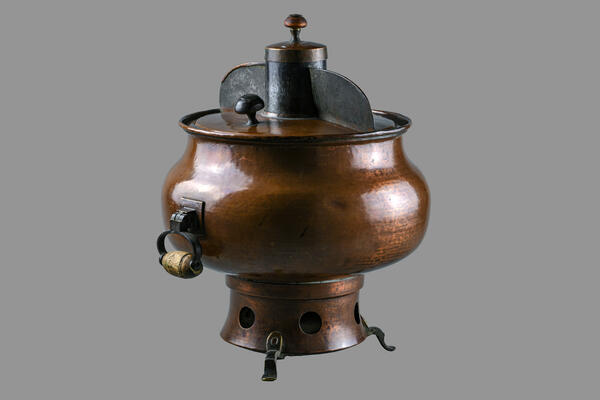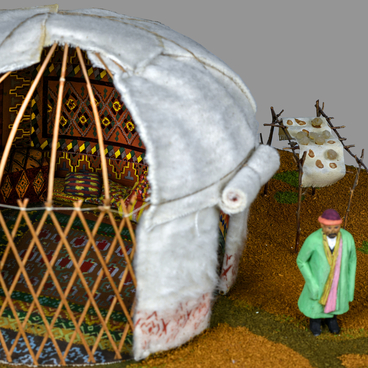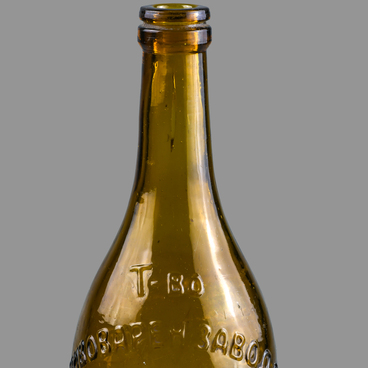The samovar is often thought of as a Russian invention, even though many other countries have always had devices for boiling water. There are traditional Chinese and Japanese devices which are, in effect, samovars, in that they combine a vessels that holds water with a chamber for charcoal and a pipe that passes through the middle of the vessel.
In Russia the ancestor of the samovar was the sbitennik, a vessel used to brew a hot drink from honey and herbs. These sbitenniks were widely used in Russia up to the XVIII Century. In form this device is similar to Asian utensils which were brought to Russia by nomadic peoples, but that does not necessarily mean that the samovar was originally inspired by similar Asian utensils.
Gradually the tea imported from China into the Russian Empire became more affordable, and began to be consumed by ordinary people, replacing the honey-based sbiten and other herbal infusions.
In Russia the ancestor of the samovar was the sbitennik, a vessel used to brew a hot drink from honey and herbs. These sbitenniks were widely used in Russia up to the XVIII Century. In form this device is similar to Asian utensils which were brought to Russia by nomadic peoples, but that does not necessarily mean that the samovar was originally inspired by similar Asian utensils.
Gradually the tea imported from China into the Russian Empire became more affordable, and began to be consumed by ordinary people, replacing the honey-based sbiten and other herbal infusions.
There is a legend that the samovar was brought to Russia by Peter I from Holland, but in reality the first factory-made samovars only appeared in Russia after the death of the emperor.
The city of Tula is often thought to be the homeland of the samovar, but, in reality, they were made in Suksun before production began in Tula. In documents from 1740 we find the first mention of a sixteen-found tin-plated copper samovar made in a workshop in Suksun. The first reference to samovars from Tula is from 1746.
In 1728 the Russian Senate issued an order requiring factories in the Urals were to master the art of manufacturing copper utensils, and in response, the factory in Suksun started making copper vessels, including samovars.
The first samovar from Tula was made in the private factory of the Lisitsyn family. Soon these utensils became very popular and there was a boom in production, so much so that by 1808 Tula had 8 factories making only samovars.
Interestingly, when the first factories were established, these vessels were known by a number of different names, including ‘samogar’ in Yaroslavl and ‘samokipets’ in Kursk.
The manufacturers started stamping their factory names on the samovars, and were awarded medals in trade fairs for their products. In Russian villages samovars were highly prized items - they were a symbol of a family’s status, prosperity and happiness. Good-quality samovars were frequently included in a daughter’s trousseau.
The cooking samovar, which contained a number of compartments separated by partitions, was an unusual and extremely useful domestic item. Two compartments could be used to cook different dishes, while a third could be used to boil water. Typically, each compartment had its own lid, while that used to boil water had a tap. The handles and stand were designed to allow the samovar to be moved around frequently and conveniently.
Cooking samovars could be used to prepare a full meal of several dishes. They were essential items for travelling peasants, merchants or soldiers, in situations when convenience was more important than gourmet cooking. These cookers were an essential item in roadside taverns and in coaching inns in small provincial towns.
The city of Tula is often thought to be the homeland of the samovar, but, in reality, they were made in Suksun before production began in Tula. In documents from 1740 we find the first mention of a sixteen-found tin-plated copper samovar made in a workshop in Suksun. The first reference to samovars from Tula is from 1746.
In 1728 the Russian Senate issued an order requiring factories in the Urals were to master the art of manufacturing copper utensils, and in response, the factory in Suksun started making copper vessels, including samovars.
The first samovar from Tula was made in the private factory of the Lisitsyn family. Soon these utensils became very popular and there was a boom in production, so much so that by 1808 Tula had 8 factories making only samovars.
Interestingly, when the first factories were established, these vessels were known by a number of different names, including ‘samogar’ in Yaroslavl and ‘samokipets’ in Kursk.
The manufacturers started stamping their factory names on the samovars, and were awarded medals in trade fairs for their products. In Russian villages samovars were highly prized items - they were a symbol of a family’s status, prosperity and happiness. Good-quality samovars were frequently included in a daughter’s trousseau.
The cooking samovar, which contained a number of compartments separated by partitions, was an unusual and extremely useful domestic item. Two compartments could be used to cook different dishes, while a third could be used to boil water. Typically, each compartment had its own lid, while that used to boil water had a tap. The handles and stand were designed to allow the samovar to be moved around frequently and conveniently.
Cooking samovars could be used to prepare a full meal of several dishes. They were essential items for travelling peasants, merchants or soldiers, in situations when convenience was more important than gourmet cooking. These cookers were an essential item in roadside taverns and in coaching inns in small provincial towns.



